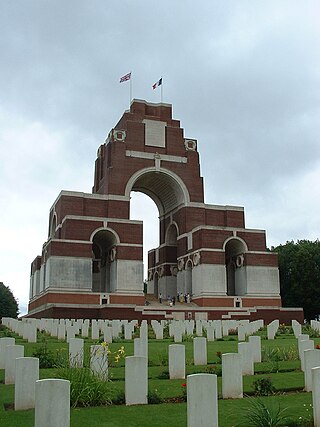
The Thiepval Memorial to the Missing of the Somme is a war memorial to 72,337 missing British and South African servicemen who died in the Battles of the Somme of the First World War between 1915 and 1918, with no known grave. It is near the village of Thiepval, Picardy in France. A visitors' centre opened in 2004. Designed by Sir Edwin Lutyens, Thiepval has been described as "the greatest executed British work of monumental architecture of the twentieth century".
The Mametz Wood Memorial commemorates an engagement of the 38th (Welsh) Division of the British Army during the First Battle of the Somme in France in 1916.
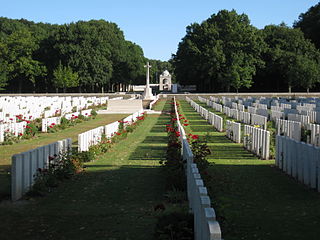
Delville Wood Cemetery is a Commonwealth War Graves Commission cemetery located near Longueval, France and the third largest in the Somme battlefield area.
Devonshire Cemetery is a small Commonwealth War Graves Commission (CWGC) burial site for some of the British Empire and Commonwealth troops killed during the Battle of the Somme. It is located near to the village of Mametz. The cemetery grounds were assigned to the British Empire in perpetuity by the French state in recognition of the sacrifices made by the Allies in the defence of France during the First World War.
Peter Arthur Barton is a British military historian, author and filmmaker specialising in trench warfare during World War I. He has published extensively on military mining and aspects of battlefield archaeology on the Western Front, and led archaeological excavations that have been featured in several Time Team episodes. His work has led to the rediscovery of many tunnels, wartime panoramas and mass graves of soldiers.

The Capture of Mametz took place on 1 July 1916, when the British Fourth Army attacked the German 2nd Army on the Western Front, during the first day of the Battle of the Somme. Mametz is a village on the D 64 road, about 20 mi (32 km) north-east of Amiens and 4 mi (6.4 km) east of Albert. Fricourt lies to the west, Contalmaison is to the north, Montauban to the north-east and Carnoy and Maricourt are to the south-east. Mametz Wood is 1,000 yd (910 m) to the north-west and before 1914, the village was the fifth largest in the area, with about 120 houses and had a station on the line from Albert to Péronne. During the Battle of Albert the II Bavarian Corps attacked westwards north of the Somme but was fought to a standstill east of Mametz. Reinforced by the XIV Reserve Corps the Germans on the north side of the Somme attacked again and took Mametz on 29 September. After a mutually costly battle for Fricourt, where the French were eventually forced out, the front line stabilised and both sides began to improvise defences. In mid-December a French local attack in the Mametz area was a costly failure.
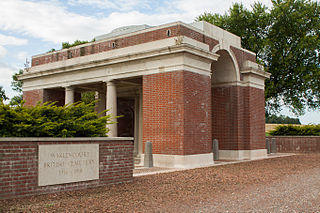
Warlencourt British Cemetery is a Commonwealth War Graves Commission burial ground for military personnel who died on the Western Front during the First World War. It is located in the Pas de Calais region of France. Established in 1919 to consolidate several smaller cemeteries, it was designed by Sir Edward Lutyens and is administered by the Commonwealth War Graves Commission (CWGC). There are 3,450 soldiers interred, over which 1,823 are unidentified. There are also memorials to 55 soldiers whose graves are unknown. The majority of the soldiers who have been identified are British, with smaller numbers of Australians, South Africans, New Zealanders, and Canadians.
Harold Chadwick Meadowcroft was an English professional footballer who played in the Football League for Glossop and Bury. He played as a right half or outside right.
Charles Edward Randall was an English professional footballer who played in the Football League for Woolwich Arsenal and Newcastle United as an inside left.

Caterpillar Valley Cemetery is a World War I Commonwealth War Graves Commission cemetery in Longueval, France.

AIF Burial Ground is a Commonwealth War Graves Commission burial ground for the dead of the First World War located near Flers on the Somme in France.
Bancourt British Cemetery is a Commonwealth War Graves Commission burial ground for the dead of the First World War located in the Pas de Calais region of France, on the Western Front.
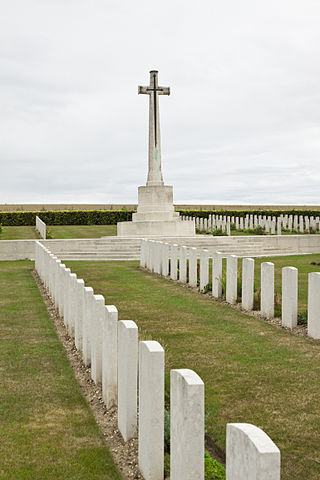
Abbeville Communal Cemetery Extension is a Commonwealth War Graves Commission burial ground for the dead of the First World War and Second World War located near Abbeville, in the Somme region of France. It is adjacent to the Abbeville Communal Cemetery.

Abbeville Communal Cemetery is a Commonwealth War Graves Commission burial ground for the dead of the First World War and Second World War located near Abbeville, in the Somme department of France. It is adjacent to the Abbeville Communal Cemetery Extension.
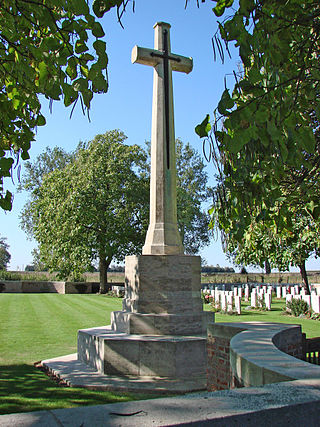
Foncquevillers Military Cemetery is a Commonwealth War Graves Commission burial ground for military personnel who died on the Western Front during the First World War. It is located in the Pas de Calais region of France. Originally established in 1915 by the French military for its soldiers, it was later used for British personnel. Designed by Sir Reginald Blomfield and administered by the Commonwealth War Graves Commission (CWGC), there are 648 soldiers of the First World War interred in the cemetery with 53 of them unidentified. Another four graves are for German soldiers of the First World War, while five Canadian airmen who died in the Second World War and a French civilian are also buried in the cemetery.

Hangard Wood British Cemetery is a Commonwealth War Graves Commission burial ground for the dead of the First World War. It is located near Villers-Bretonneux, in the Somme department of France.
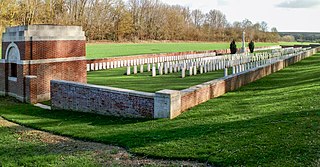
Norfolk Cemetery is a Commonwealth War Graves Commission (CWGC) burial ground for the dead of the First World War. It is located at the village of Bécordel-Bécourt, near Albert in the Somme department of France.

The Bazentin-le-Petit Communal Cemetery Extension is a cemetery located in the Somme region of France commemorating British and Commonwealth soldiers who fought in the Battle of the Somme in World War I. The cemetery contains mostly those who died from 14 July 1916 to December 1916 near Bazentin-le-Petit and those who died on battlefields near the villages of Bazentin and Contalmaison.

The Bernafay Wood British Cemetery is a cemetery located in the Somme region of France commemorating British and Commonwealth soldiers who fought in the Battle of the Somme and against the German 1918 spring offensive in World War I. The cemetery contains mostly those who died between July 1916 and April 1917 and March–August 1918.














